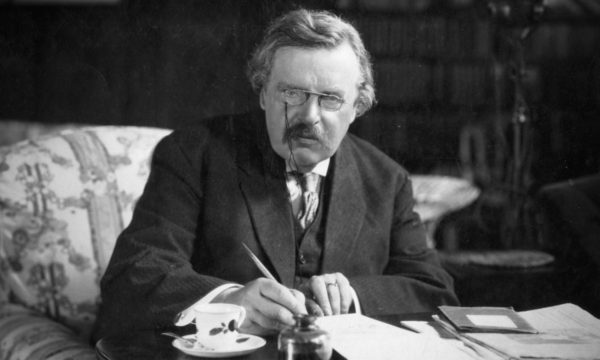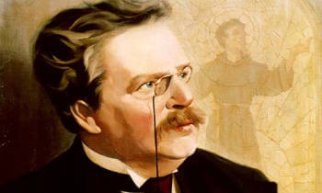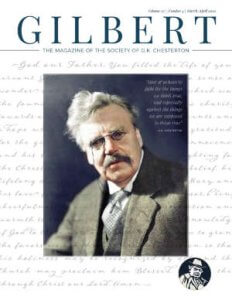Every one of Chesterton’s novels is in some way a tribute to Charles Dickens: Pickwickian ensembles, broad-brushed emotion, extravagant variations on eternal struggles. As a painter borrowing a classic pose or technique from another painter’s masterpiece, so Chesterton models some of his literary scenes on those created by Dickens. A prime example of this is the opening passage of Manalive, where Chesterton’s vivid description of a great wind blowing into town evokes Dickens’ description of the immense fog that creates the mood at the beginning of Bleak House. But the great wind also epitomizes the freshness of Chesterton’s ideas; it briskly blows away all of the fog that clings in the corners of conventionality.
Chesteron also borrows from another great writer: himself. Manalive also reminds us of the beginning of Orthodoxy. In that book he starts off by describing a book he did not write, a romance about a man who sets off to discover a new land, but who unknowingly gets turned around and ends up re-discovering his own land, seeing it as if for the first time, where everything strikes him as being at once both strange and familiar. In a sense, Manalive, which was published four years after Orthodoxy, is that romance that Chesterton said he never wrote. This novel is about seeing old things in a new way, of seeing common and expected things in a surprising and fantastic way, and of seeing all things the proper way – which is upside down, the way St. Peter saw them when he had the honor of being crucified in a topsy-turvy position: “I’ve often fancied his humility was rewarded by seeing in death the beautiful vision of …the landscape as it really is: with the stars like flowers, and the clouds like hills, and all men hanging on the mercy of God.” It is an everlasting mercy that we don’t fall off.
The hero of the story has the best name of any of Chesterton’s characters, and one of the best names in all of fiction: Innocent Smith. “Smith” is the name of the Common Man. “Innocent” is the name of purity and sweetness and awe at the universe. It is not ignorance. It is a knowledge unsullied by cynicism. Innocent Smith is a man who keeps the commandments and breaks the conventions. He is the opposite of the modern man whom Chesterton describes in his famous essay, “On Lying in Bed”: “Our views change constantly; but our lunch does not change.” Innocent Smith knows how to change his lunch. He has a picnic – on the roof! And when he breaks the conventions, he is often mistaken for breaking the commandments. He breaks, for instance, into a house late at night, just like a thief. But it is his own house. He has a torrid love affair. With his own wife. He then leaves his home and his wife, and travels all the way around the world so that he may return home. Taking the long way home, as it were. The ultimate purpose of any trip is to get home. No matter where we go, home is our destination.
He also shoots at pessimistic professors. Now this could hardly be considered a sin, but we should point out that he does it not to kill them but to startle them with a new appreciation of life. And how do the other characters react to Innocent Smith? Everyone is shocked, of course. But for opposite reasons. Some think he is quite mad, and they seek to have him put away, where he will no longer bother to them. Some think he is the first sane person they have ever met, that knowing him is like stepping into the light for the first time. Only one person is not shocked by him: the woman who is married to him and loves him. The reactions are not unlike the reactions to Chesterton himself.
So, is Innocent Smith really G.K. Chesterton? Well, let me say this: this novel is Chesterton’s most practical and least theoretical book. This is the book on how to live Chesterton. I have found that people either love this book or are neutral about it. There is no hating it. And if you are neutral about it, well, you need to go have a picnic on the roof.





